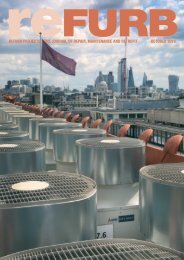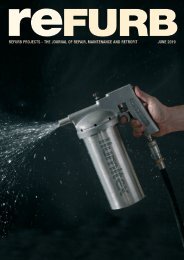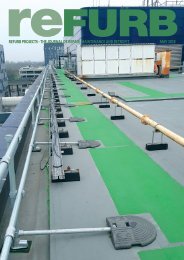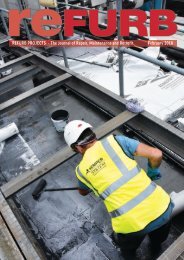Refurb Projects April 2017
Refurb Projects launched in 1987 to cater for the expanding Repair, Maintenance, Improvement and Refurb sectors of the UK Building Industry. Sustainability and the protection of the built environment are essential ingredients of the refurbishment market, and Refurb Projects Journal is a leader in reporting and promoting these ideals.
Refurb Projects launched in 1987 to cater for the expanding Repair, Maintenance, Improvement and Refurb sectors of the UK Building Industry.
Sustainability and the protection of the built environment are essential ingredients of the refurbishment market, and Refurb Projects Journal is a leader in reporting and promoting these ideals.
- No tags were found...
You also want an ePaper? Increase the reach of your titles
YUMPU automatically turns print PDFs into web optimized ePapers that Google loves.
BUILDING SERVICES<br />
KO for CO<br />
Developers and housing providers should take the lead in reducing carbon monoxide poisoning in<br />
housing, in view of conflicting CO alarm regulations, as leading manufacturer Kidde Safety explains.<br />
water rather than acid-based<br />
electrolytes as well.<br />
According to all the Regulations<br />
and BS EN 50292:2013 alarms can<br />
be powered by batteries designed<br />
for the whole working life of the<br />
alarm or by mains. Hard-wired<br />
alarms are easily installed in newbuilds,<br />
refurbishments or re-wiring<br />
projects alongside hard-wired smoke<br />
and heat alarms and together can<br />
offer extra safety features. For<br />
example, Kidde’s 4MCO and 4MDCO<br />
hard-wired CO alarms can be<br />
interlinked not only with each other<br />
but also with the company’s Firex<br />
range of hard-wired smoke and heat<br />
alarms, using the unique ‘Smart<br />
Interconnect’ feature for extra<br />
security.<br />
Building Regulations<br />
throughout the UK all<br />
require CO alarms to<br />
varying degrees with<br />
installation of some new or<br />
replacement combustion heating<br />
appliances – but excluding cookers.<br />
A much more robust benchmark is<br />
BS EN 50292:2013 which<br />
recommends a CO alarm in every<br />
room containing any fuel-burning<br />
appliance and also in other wellused<br />
rooms, as well as all bedrooms.<br />
Where the number of CO alarms has<br />
to be limited, flue-less or open-flue<br />
appliances and rooms where<br />
occupants spend most time should<br />
be prioritised, as well as those with<br />
extended or concealed flues passing<br />
through.<br />
BS EN 50292’s more rigorous<br />
approach contrasts particularly<br />
starkly with Building Regulations<br />
Approved Document J applying to<br />
England and Wales. This only<br />
requires a CO alarm with installation<br />
of certain, solid fuel heating<br />
appliances. The continuing toll of<br />
deaths and illness resulting from CO<br />
incidents associated with other fuels<br />
and types of combustion appliances<br />
– including cookers – highlights the<br />
urgent need for a better benchmark<br />
than this.<br />
LONG-TERM RELIABILITY<br />
But apart from the number of CO<br />
alarms, confidence in the long-term<br />
reliability of alarms is also essential<br />
– particularly as there are noncompliant<br />
products on the market.<br />
An established manufacturer with a<br />
reputation for quality, supported by<br />
third party accreditation, is<br />
essential for peace of mind. For<br />
example, all Kidde CO alarms,<br />
whether hard-wired or battery, are<br />
BSi Kitemarked. Kidde also<br />
manufactures its own sensors,<br />
allowing tighter quality controls to<br />
be applied. And Kidde uses safer,<br />
environmentally friendly de-ionised<br />
MAKING THE RIGHT CHOICE<br />
Importantly, with Smart<br />
Interconnect all the alarms have<br />
different, distinct alarm sounder<br />
patterns for carbon monoxide and<br />
fire, supported by different display<br />
messages on the digital CO model.<br />
So, without the need for any further<br />
operation of the system (such as<br />
remote switches), Smart<br />
Interconnect automatically alerts<br />
occupants of the specific hazard<br />
that confronts them. It allows them<br />
to respond quickly, making the right<br />
choice from the very different<br />
potential actions for either fire or<br />
carbon monoxide.<br />
In many situations, fitting a<br />
battery-only CO alarm may be<br />
simplest and, of course, battery<br />
quality is key to long term, problemfree<br />
performance. With this in mind,<br />
Kidde’s self-contained 10LLCO and<br />
10LLDCO carbon monoxide alarms<br />
enjoy a full 10-year guarantee<br />
covering both the alarm and sealedin<br />
lithium battery. These alarms are<br />
small in size with a slim profile and<br />
can be wall-mounted or used free<br />
standing.<br />
They are simply activated by the<br />
slide-on back plate, so preserving<br />
battery freshness until needed, and a<br />
tamper resisting self-locking<br />
installation system avoids battery<br />
theft. An event activity data log for<br />
each alarm is also available, upon<br />
request from Kidde.<br />
For more information,<br />
call: 01753 766392,<br />
Email: sales@kiddesafety.co.uk or<br />
visit: www.kiddesafetyeurope.co.uk<br />
6 APRIL <strong>2017</strong>, REFURBISHMENT PROJECTS

















